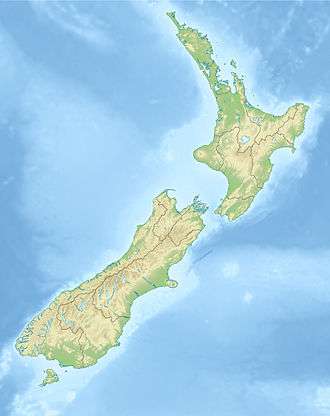Katiki Formation
The Katiki Formation is a Late Cretaceous (Campanian to Maastrichtian, or Haumurian in the regional stratigraphy) geologic formation of the South Island of New Zealand.[1] Plesiosaur remains of Kaiwhekea katiki, named after the formation, are among the fossils that have been recovered from the deltaic siltstones.
| Katiki Formation Stratigraphic range: Campanian-Maastrichtian (Haumurian) ~83.5–66 Ma | |
|---|---|
| Type | Geological formation |
| Overlies | Herbert Formation |
| Thickness | 100 m (330 ft) |
| Lithology | |
| Primary | Siltstone |
| Location | |
| Coordinates | 45.5°S 170.8°E |
| Approximate paleocoordinates | 60.3°S 153.5°E |
| Region | South Island |
| Country | New Zealand |
| Type section | |
| Named by | McKay |
| Year defined | 1887 |
 Katiki Formation (New Zealand) | |
Description
The Katiki Formation was defined by McKay in 1887 and comprises about 100 metres (330 ft) of gently north to northeast dipping and generally massive, dark grey, indurated, sandy siltstones. The Katiki Formation overlies more proximal marine sandstones of the Herbert Formation and, below that, non-marine quartzose sandy to pebbly coal measures of the Shag Point Group.[2]
Fossil content
- Belemnites
- Reptiles
- Dinophyceae
- Gonyaulacaceae
- Cribroperidinium edwardsii
- Peridiniaceae
- Chatangiella campbellensis
- Palaeocystodinium granulatum
- Gonyaulacaceae
gollark: Maybe I should make a TOML to LXDE-weird-XML-config converter.
gollark: IKR, right?
gollark: You can rebind them in `~/.config/openrc/lxde-rc.xml`.
gollark: Well, that was a somewhat strange conversation, but... good?
gollark: So what's the problem?
See also
References
- Katiki Formation in the Paleobiology Database
- Shag Point in the Paleobiology Database
- Cruickshank & Fordyce, 2002
Bibliography
- Cruickshank, A.R.I., and R.E. Fordyce. 2002. A new marine reptile (Sauropterygia) from New Zealand: further evidence for a Late Cretaceous Austral radiation of cryptoclidid plesiosaurs. Palaeontology 45. 557–575.
This article is issued from Wikipedia. The text is licensed under Creative Commons - Attribution - Sharealike. Additional terms may apply for the media files.